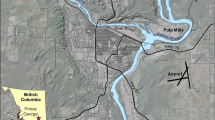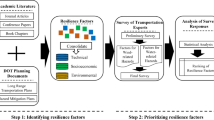Abstract
Multi-level governance networks provide both opportunities and challenges to mainstream climate change adaptation due to their routine decision-making and coordination processes. This paper explores institutionalizing resilience and adaptation to climate change in the intergovernmental transportation planning processes that address bridge infrastructure in the Northeastern United States (USA), specifically in Vermont and Maine. The research presented here relies on nine interviews with policy-makers and planners, a survey of transportation project prioritization criteria, development of a longitudinal bridge funding database, and its integration with publicly available geospatial data. It presents a novel spatial analysis methodology, a modified version of which could be adopted by transportation agencies for prioritizing scarce adaptation funds. Although transportation agencies are undertaking a variety of mitigation activities to address business-as-usual needs, climate change adaptation and resilience efforts remain underprioritized. Adaptation is a global concern, but impacts vary dramatically between regions and require localized solutions. Bridges and culverts, which are especially vulnerable to climate-induced flooding impacts, have complex maintenance and design processes and are subject to convoluted adaptation planning procedures. Critical gaps in resources and knowledge are barriers to improved adaptation planning. Restructuring the transportation project prioritization procedures used by planning organizations to explicitly include adaptation may provide a novel strategy to institutionalize resilience in transportation. These procedures must be considered in the context of the intergovernmental networks that exist to support transportation infrastructure. Although these networks will likely vary across countries, the approaches introduced here to study and address transportation infrastructure adaptation may be applied to many settings.




Similar content being viewed by others
Notes
The organizations from which participants were interviewed are the VTrans, the MaineDOT, Chittenden County Regional Planning Commission (CCRPC), Boston MPO, Kittery Area Comprehensive Transportation System (KACTS), Portland Area Comprehensive Transportation System (PACTS), and Bangor Area Comprehensive Transportation System (BACTS).
References
Bierbaum R, Smith JB, Lee A et al (2013) A comprehensive review of climate adaptation in the United States: more than before, but less than needed. Mitig Adapt Strat Glob Chang 18:361–406
Bonnin GM, Maitaria K, Yetka M (2001) Trends in rainfall exceedances in the observed record in selected areas of the United States. J Am Water Resour Assoc 46(2):344–353
Boston Region MPO (2013) FFYs 2014–17 TIP evaluation scoring. www.ctps.org/Drupal/data/pdf/plans/TIP/TIP_Evaluation_Scoring.pdf. Cited 6 March 2015
Cambridge Systematics, Bipartisan Policy Center (2009) Transportation adaptation to global climate change. http://bipartisanpolicy.org/library/research/transportation-adaptation-global-climate-change. Cited 6 March 2015
Chittenden County Regional Planning Commission (2011) Prioritization of transportation projects. www.ccrpcvt.org/library/CIRC/docs/VTrans_CCRPC_Prioritization_Methdology_20110805.pdf. Cited 6 March 2015
Croope SV, McNeil S (2011) Improving resilience of critical infrastructure systems postdisaster: recovery and mitigation. Transp Res Rec 2234:3–13
Downing D, Noland RB (1998) Environmental consequences of reducing the federal role in transportation: legal framework. Transp Res Rec 1626:3–10
Eisenack K, Stecker R, Reckien D, Hoffman E (2012) Adaptation to climate change in the transport sector: a review of actions and actors. Mitig Adapt Strateg Glob Chang 17:451–469
Federal Highway Administration (2011) Geographic information systems applications for climate change decision-making: peer exchange summary report. https://www.gis.fhwa.dot.gov/documents/GIS_for_Climate_Change_Proceedings.pdf
Federal Highway Administration (2012) Climate change and extreme weather vulnerability assessment framework. http://www.fhwa.dot.gov/environment/climate_change/adaptation/publications_and_tools/vulnerability_assessment_framework/fhwahep13005.pdf
Gallivan F, Ang-Olsen J, Turchetta D (2009) Integrating climate change into state and regional transportation plans. Transp Res Rec 2119:1–9
Gillespie N, Unthank A, Campell L, Anderson P, Gubernick R, Weinhold M, Cenderelli D, Austin B, McKinley D, Wells S, Rown J, Orvis C, Hudy M, Bowden A, Singler A, Fretz E, Levine J, Kirn R (2014) Flood effects on road-stream crossing infrastructure: economic and ecological benefits of stream simulation designs. Fisheries 39(2):67–76
Horton R, Yohe G, Easterling W et al. (2014) Chapter 16: Climate change impacts in the United States: the third National Climate Assessment. In: Melillo JM et al. (eds) Climate change impacts in the United States: the third national climate assessment. Available via US Global Change Research Program. http://nca2014.globalchange.gov/report/regions/northeast. Cited 12 June 2014
Hunt A, Watkiss P (2011) Climate change impacts and adaptation in cities: a review of the literature. Clim Chang 104(1):13–49
IPCC (2013) Climate change 2013: the physical science basis. Contribution of working group I to the fifth assessment report of the intergovernmental panel on climate change. www.climatechange2013.org. Cited 2 May 2014
Jaroszweski D, Chapman L, Petts J (2010) Assessing the potential impact of climate change on transportation: the need for an interdisciplinary approach. J Transp Geogr 18(2):331–335
Johnson I (2012) Adapting Vermont’s transportation infrastructure to the future impacts of climate change: VTrans climate adaptation white paper. http://vtransplanning.vermont.gov/sites/aot_policy/files/documents/planning/Climate%20Change%20Adaptation%20White%20Paper.pdf. Cited 15 May 2014
Kehew RB, Kolisa M, Rollo C et al (2013) Formulating and implementing climate change laws and policies in the Philippines, Mexico (Chiapas), and South Africa: a local government perspective. Local Environ 18(6):723–737
Koliba C, Meek J, Zia A (2010) Governance networks in public administration and public policy. CRC Press/Taylor & Francis, Boca Raton
Lowe A, Foster J, Winkelman S (2009) Ask the climate question: adapting to climate change impacts in urban regions. Center for Clean Air Policy (CCAP), Washington, DC
Lysák M, Bugge-Henricksen C (2014) Current status of climate change adaptation plans across the United States. Mitig Adapt Strateg Glob Chang. doi:10.1007/s11027-014-9601-4
Maine Department of Transportation (2000–2014) Statewide transportation improvement programs. http://www.maine.gov/mdot/stip/. Cited 15 July 2014
Masozeraa M, Bailey M, Kerchnerc C (2007) Distribution of impacts of natural disasters across income groups: a case study of New Orleans. Ecol Econ 63:299–306
McBeath J (2003) Institutional responses to climate change: the case of the Alaska transportation system. Mitig Adapt Strateg Glob Chang 8(3):3–28
Meyer M, Amedkudzi A, O’Har JP (2010) Transportation asset management systems and climate change: adaptive systems management approach. Transp Res Rec 2160:12–20
Moretto M (2013) LePage sees upside for global warming in Maine with opening of northeast passage. Bangor Daily News. 5 December 2013. http://bangordailynews.com/2013/12/05/politics/lepage-sees-upside-for-global-warming-in-maine-with-opening-of-northeast-passage/. Cited 30 June 2014
National Cooperative Highway Research Program (2014) Strategic issues facing transportation: climate change, extreme weather events, and the highway system: practitioner’s guide and research report. Report 750(2). http://onlinepubs.trb.org/onlinepubs/nchrp/nchrp_rpt_750v2.pdf. Cited 30 June 2014
Novak D, Koliba C, Zia A, Tucker D (2015) Evaluating the outcomes associated with an innovative change in a state-level transportation project prioritization process: a case study of Vermont. Transport Policy
Oswald MR, McNeil S (2013) Methodology for integrating adaptation to climate change into the transportation planning process. Public Works Manag Policy 18(2):145–166
Plumeau P, Lawe S (2009) Meeting the challenge of institutional fragmentation in addressing climate change in transportation planning and investment. Transp Res Rec 2139:81–87
Regmi M, Hanaoka S (2011) A survey on impacts of climate change on road transport infrastructure and adaptation strategies in Asia. Environ Econ Policy Stud 12(1):21–41
Revi A, Satterthwaite DE, Aragón-Durand F et al. (2014) Urban areas. In: Climate change 2014: impacts, adaptation, and vulnerability. Part A: global and sectoral aspects. Contribution of Working Group II to the fifth assessment report of the Intergovernmental Panel on Climate Change [Field CB, Barros VR, Dokken DJ et al. (eds.)]. Cambridge University Press, Cambridge, United Kingdom and New York, NY, USA, 535–612
Roberts D, O’Donoghue S (2013) Urban environmental challenges and climate change action in Durban, South Africa. Environ Urban 25(2):299–319
Rowan E, Evans C, Riley-Gilbert M, Hyman R, Kafalenos R, Beucler B, Rodehorst B, Choate A, Schultz P (2013) Assessing the sensitivity of transportation assets to extreme weather events and climate change. Transp Res Rec 2326:16–23
Russell E, Cousins C, Curtis A, Lynds J (2011) Thousands without power, bridges closed as state cleans up after Irene. Bangor Daily News. 29 August 2011. http://bangordailynews.com/2011/08/29/news/state/the-cleanup-from-irene-begins-nearly-200000-mainers-without-power/. Cited 2 July 2014
Savonis MJ, Burkett VR, Potter JR (eds) (2008) Impacts of climate change and variability on transportation systems and infrastructure: Gulf Coast study, phase I. US Department of Transportation; Washington, DC
Schmidt N, Meyer MD (2009) Incorporating climate change considerations into transportation planning. Transp Res Rec 2119:66–73
Springston G, Underwood K (2012) Impacts of tropical storm Irene on streams in Vermont. http://www.anr.state.vt.us/dec/geo/pdfdocs/IreneGeomorphRevised02142012small.pdf
US Government Accountability Office. (2014) Emergency transportation relief: agencies could improve collaboration begun during Hurricane Sandy response. GAO-14-512. http://www.gao.gov/products/GAO-14-512. Cited 2 July 2014
Venner M, Zamurs J (2012) Increased maintenance costs of extreme weather events: preparing for climate change adaptation. Transp Res Rec 2292:20–28
Vermont Agency of Natural Resources (2014) Stream alteration general permit. http://www.watershedmanagement.vt.gov/rivers/docs/2014_04_10_Stream_Alteration_GP.pdf. Cited 30 June 2014
Vermont Agency of Transportation (2000–2014) Capital Programs. http://vtrans.vermont.gov/about-us/capital-programs. Cited 30 May 2014
Walker L, Figliozzi MA, Haire AR, MacArthur J (2011) Climate action plans and long-range transportation plans in the Pacific Northwest and Alaska. Transp Res Rec 2252:118–126
Walsh J, Wuebbles D, Haykoe K et al. (2014) Chapter 2: Our changing climate. In: Melillo JM et al. (eds) Climate change impacts in the United States: the third national climate assessment. Available via US Global Change Research Program. http://nca2014.globalchange.gov/report/sectors/transportation. Cited 5 July 2015
Wu Y, Hayat T, Clarens A, Smith BL (2013) Climate change effects on transportation infrastructure: scenario-based risk analysis using geographic information systems. Transp Res Rec 2375:71–81
Zia A, Koliba C (2013) The emergence of attractors under multi-level institutional designs: agent-based modeling of intergovernmental decision-making for funding transportation projects. AI & Society: Knowledge, Culture, and Communication. http://link.springer.com/article/10.1007/s00146-013-0527-2/fulltext.html. Cited 5 May 2014
Acknowledgments
We gratefully acknowledge funding from the United States Department of Transportation via the University of Vermont Transportation Research Center and National Science Foundation EPS-1101317.
Compliance with ethical standards
The authors bear complete responsibility for all the data and information provided in this manuscript. The authors also verify that there are no conflicts of interest; that this manuscript has not been simultaneously submitted in full or in part to another journal; that no part of this manuscript has already been published; that no animal subjects were used in research; that human subjects were used only as non-personal interview sources; and that those individuals provided informed consented for the use of their statements in our research findings.
Author information
Authors and Affiliations
Corresponding author
Rights and permissions
About this article
Cite this article
Schulz, A., Zia, A. & Koliba, C. Adapting bridge infrastructure to climate change: institutionalizing resilience in intergovernmental transportation planning processes in the Northeastern USA. Mitig Adapt Strateg Glob Change 22, 175–198 (2017). https://doi.org/10.1007/s11027-015-9672-x
Received:
Accepted:
Published:
Issue Date:
DOI: https://doi.org/10.1007/s11027-015-9672-x




